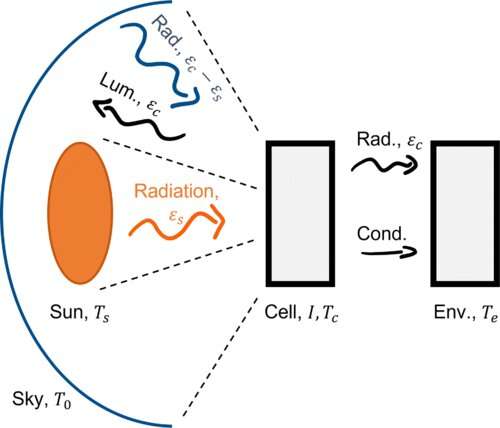This article has been reviewed according to Science X's editorial process and policies. Editors have highlighted the following attributes while ensuring the content's credibility:
fact-checked
trusted source
proofread
New approach for understanding temperature effects on photovoltaic device performance

Photovoltaic technology is indispensable for our ability to mitigate climate change. Nonetheless, more than 70% of the energy made available to us by the sun is wasted in conventional photovoltaic cells. There is little hope for sustainable technological advancement without addressing this issue.
The operational temperature is a critical factor in a solar cell's ability to convert sunlight to free energy. Accordingly, much research has been directed toward understanding the temperature effects in the efficiency of photovoltaic solar cells. Surprisingly, however, little is known about what this temperature would end up being.
In a paper, "Effect of maintaining a fixed ambient temperature on the evaluation of photovoltaic device performance," published in Physical Review Applied last week, researchers from the Ben-Gurion University of the Negev Solar Energy Research Center, answer this question by balancing the photon and energy rates of the photovoltaic effect.
Their new approach theorizes a fluctuation in temperature in response to the heat produced from light absorptance and the connection to a fixed temperature environment, whereas present analyses are based on the premise that the cell temperature would remain fixed regardless of its operational conditions.
"This article's solid theoretical grasp is a prerequisite for significant technological advancement. Therefore, illuminating the hidden aspects of the photovoltaic effect contributes to realizing disruptive concepts, such as thermoradiative and thermophotonic cells," says lead author Dr. Avi Niv.
Thermoradiative and thermophotonic cells are advanced conceptions of photovoltaic energy conversion that enable industrial processes's waste heat recovery (thermoradiative) or are more efficient in converting the sun's radiative energy flux to electricity (thermophotonic).
More information: Ido Frenkel et al, Effect of Maintaining a Fixed Ambient Temperature on the Evaluation of Photovoltaic Device Performance, Physical Review Applied (2023). DOI: 10.1103/PhysRevApplied.19.064023
Provided by Ben-Gurion University of the Negev





















